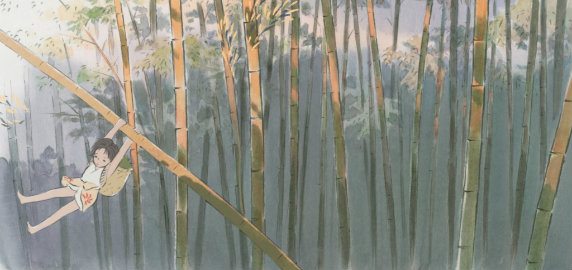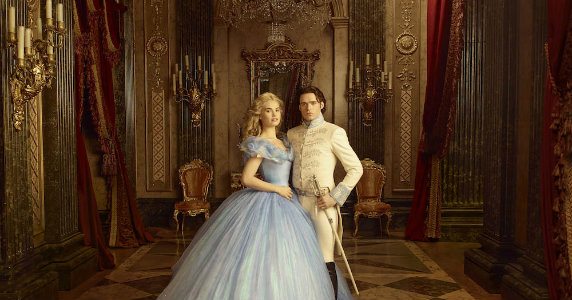Stories from the West, Tales from the East
We’ve recently seen the release of two similarly-themed films. One is Cinderella, a Disney production of the classic fairy tale about a girl with the world’s worst stepmother, helmed by Kenneth Branagh; the other is The Tale of Princess Kaguya, which comes from Japan’s Studio Ghibli, and is likely to be the final work of the legendary animation director Isao Takahata.
Both are adaptations of stories that date back centuries in their respective cultures. We might know Cinderella from the Brothers Grimm, whose book of fairy tales included classics like Snow White and Hansel and Gretel, but it actually dates back further than this; Charles Perrault wrote an edition of the fairy tale in his 1697 book Histoires ou contes du temps passé, though a story entitled “Cenerentola” by Italian poet Giambattista Basile in 1634 may be the first written account of the story as we know it. Even these authors likely borrowed elements from their predecessors, for the figure of a persecuted young heroine recurs throughout history. An ancient tale from Greek geographer Strabo, about a courtesan named Rhodopis, contains a curiously familiar plot, where the king of Egypt searching for the foot which matches a shoe delivered to him by an eagle.
Kaguya’s origins are more clear-cut, in that it’s based upon the 10th-century Japanese folktale The Tale of the Bamboo Cutter, supposedly Japan’s oldest prose narrative. For the unaware, it’s about a woodcutter who discovers a tiny princess inside a glowing bamboo shoot, who transforms into a child both him and his wife decide to raise as their own. After finding a cache of gold he decides to integrate the princess into royal society, which ends on a poignant note. Having never visited or lived in Japan I’m unsure of this tale’s resonance within popular culture, though I suspect it’s significant (any legend adapted into an episode of Naruto is a good one in my book).
Of course, what separates these two films is their differing approaches to adapting an ancient story for a modern audience. By changing the title of the original story, Takahata places emphasis on the young woman of the piece – and rightly so, for The Tale of Princess Kaguya participates in the rich Ghibli tradition of crafting a modern, likeable young heroine to stand alongside greats like Chihiro and Kiki. Kaguya may be a magical being from a faraway land but she’s as human as any of us, and through observing her struggle with relationships, adulthood, and the rigid structure of ancient Japanese society both children and adults alike can take away something meaningful from this re-imagining of an ancient fable.
Cinderella, on the other hand, is very different. It’s true that both of these films are aware of their traditional presentation; Branagh’s adaptation isn’t one where she works at a coffee shop in New York and Prince Charming is a hobo or a well-groomed dog or something, it’s a straightforward period piece, much like Kaguya (which seems to consciously evoke ancient Japanese art with a pencil-and-watercolour design). But over the years the Cinderella story has received a lot of criticism for being problematic, and Branagh doesn’t really address this. His Cinderella is still a beautiful stick-thin heroine who doesn’t really take the lead in changing her own fate, instead relying on others – the fairy godmother, the prince – to rescue her. This was fine in the seventeenth century, where the word ‘suffragette’ was used to describe the sound of a sneeze, but now, in an age of Anna and Elsa, feels quite regressive. Kids will love the film, but will they love it for the right reasons, and what will they take away from it?
Perhaps I’m being too harsh, and perhaps setting up a dichotomy between the superior East and inferior West is a mistake. After all, there’s a lot more cultural interchange between the two cultures than we think; the Cinderella myth has proliferated countries from Korea to Vietnam, the latter spinning a delightful version of the tale where Cinderella feeds her ugly sisters to the stepmother, Titus Andronicus-style, and maybe the problem of the Branagh film lies with its individual adaptation rather than the myth itself, or even Disney. After all, the production company has made countless good films drawing from a wide range of cultural sources, with decent heroes and heroines for children to attach themselves too. Frozen is only the latest in a long string of films that examine the past from a modern standpoint, Mulan perhaps being the most notable example.
I loved every minute of The Tale of Princess Kaguya, and I found myself bored throughout most of Cinderella. But was this because, as a Western spectator, I found the unfamiliar, spiritual mythology of the former more enthralling? Or was it because I thought the latter didn’t work as a film? I suspect it’s a bit of both.
And Studio Ghibli itself has drawn on countless Western sources in crafting its imaginative animated yarns. Hayao Miyazaki’s first film for the studio, Laputa: Castle in the Sky, borrowed the concept of a civilization concealed by a floating island from a chapter in Gulliver’s Travels, and his 1992 film Porco Rosso owes as much to Howard Hawks as any kind of Japanese mythology. I don’t think it would be unfair to say that much of the studio’s eventual success in the West was due to an audience’s desire to see exotic Japanese traditions and rituals dramatised before their very eyes; many critics assumed the colourful creatures from Spirited Away were gods and monsters from, say, Buddhist texts, yet most of them were plucked independently from the minds of their animators.
I loved every minute of The Tale of Princess Kaguya, and I found myself bored throughout most of Cinderella. But was this because, as a Western spectator, I found the unfamiliar, spiritual mythology of the former more enthralling? Or was it because I thought the latter didn’t work as a film? I suspect it’s a bit of both, and I suspect that seeing it weeks after Into the Woods didn’t help either. That might be the problem; as a culture, we’ve worn these stories into the ground, and trying to start afresh just seems frustrating. But who knows, maybe the Japanese feel the same way about the story of a woodcutter?
Images: Studio Canal/Disney



Comments